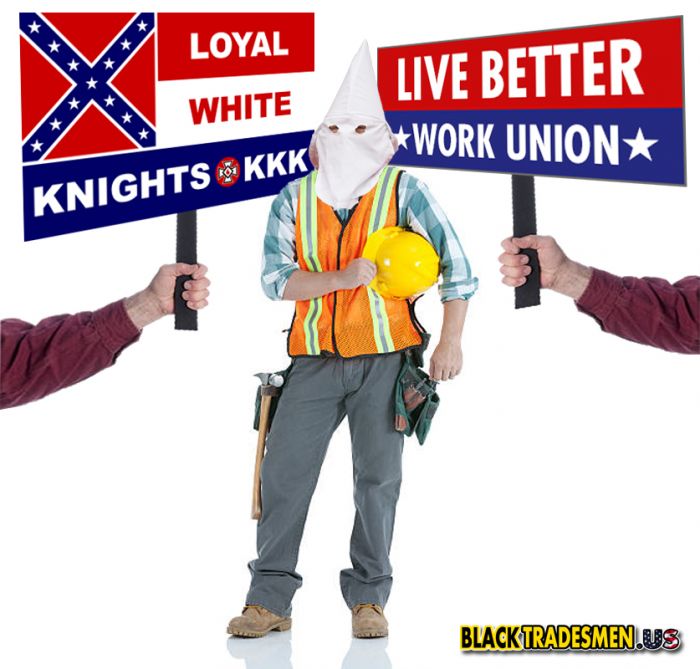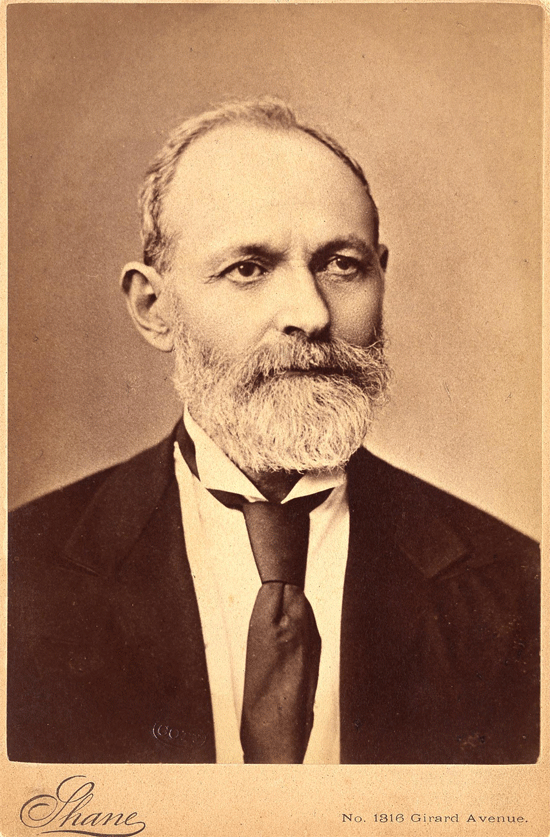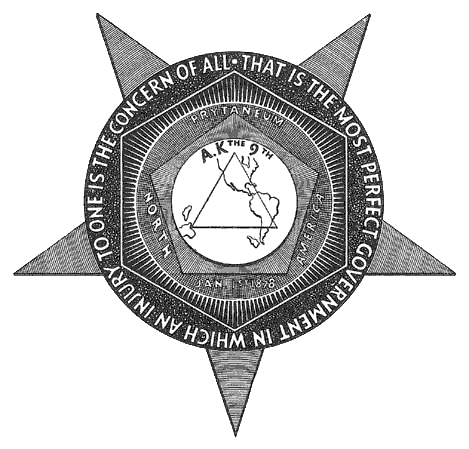The invisible hand that controls American Labor Unions: The KKK and KOL

Today, operating mostly as an underground, yet still highly relevant and highly effective organization established to maintain white superiority, the 'Knights of the Ku Klux Klan’ (KKK), who were a spin off from the Freemasons after the American Civil is a terrorist group that still has its poisonous tentacles operating secretively in all areas of American government, law enforcement, education, media, and oh yeah, labor.
The most infamous of these unions was the ‘Noble and Holy
Order of the Knights of Labor’, later renamed ‘The Knights of Labor’ (KOL), which
was the first national industrial union in the United States. Founded in Philadelphia
in 1869 by Freemason Baptist Preacher Uriah Stephens, along with eight others,
‘The Knights of Labor’ was established as a platform on which to build white
working-class unity. While Freemasonry tended to attract members of the
economic elites, especially white merchants, retailers and investors, the
‘Knights of Labor’ membership encompassed all elements of the white working
class.

Founded four years after the creation of the ‘Knights of the
Ku Klux Klan’, Stephens also stressed the importance of solidarity within the
ranks of the ‘Knights of Labor’ in order to facilitate white superiority over
black American workers. He felt that the union should be a voluntary group of
white men working cooperatively and fraternally to safe guard white worker’s
interest.
This KOL method of accepting small amounts of black workers,
and separating black workers economically from other black workers performing
the same trades, has proved very fruitful for today’s American labor unions. By
harnessing some black worker support, the KOL was able to appear to the public
as a moderately progressive organization, while spearheading white male
dominance over the entire American workforce.
Black tradesmen that became members of the KOL were only
allowed to meet separately from white KOL members, in segregated union halls, with
white supervision, and had little if any vote on the organizations overall
policies.
Black only KOL union members were relegated to work only in
black communities, and amongst themselves. In fact, the modern construction
industry today in the U.S. finds its historic roots tied to this legacy of
castigating black tradesmen to the same effect when implementing so-called
‘Project Labor Agreements’ (PLA) and ‘Local Hire Programs’ primarily targeting
black workers. The modern PLA is a direct spin-off from the Knights of Labor
racist policies from over 100 year ago.
Racial divisions within the Knights of Labor were primarily
leveraged to prevent unity amongst black working class people and derail collective
bargaining efforts, which would have resulted in true economic gains for the
black working class.
It's been said that white supremacist always play both sides
of an argument in order to draw victory by any means possible for the white
race. While the KKK was the premier ultra-violent right-wing, the KOL was setup
to serve as the quintessential blue collar left-wing of the white supremacists
Masonic orders of Freemasonry. Both organizations used secret rituals borrowed
from Freemasonry when meeting in private.
Take for example the Thibodaux massacre of 1887 , which
killed more than 50 black members of the Knights of Labor, following a
three-week strike during the critical sugar harvest season by an estimated
10,000 workers, mostly black, against sugar cane plantations in Louisiana.
The strike was the first conducted by the Knights of Labor, who strongly
opposed strikes, due to their secret alliances with white elites.
The Opelousas Courier , a black owned newspaper described the scene:
'Six killed and five wounded' is what the daily papers here
say, but from an eye witness to the whole transaction we learn that no less
than thirty-five "...fully thirty negroes have sacrificed their lives in
the riot on Wednesday..." Negroes were killed outright. Lame men and blind
women shot; children and hoary-headed grandsires ruthlessly swept down! The
Negroes offered no resistance; they could not, as the killing was unexpected.
Those of them not killed took to the woods, a majority of them finding refuge
in this city.'
During and even after the Thibodaux massacre the Knights of Labor
did nothing to neither protect nor stop violence perpetuated by their democratic
Klan brothers against their black union members.
Albert Pike, who held the office of Chief Justice of the Ku Klux Klan while he was simultaneously Sovereign Grand Commander of the Scottish Rite, Southern Jurisdiction expressed his concept of Masonic brotherhood’s such as the Knights of Labor allowing black members to join:
"I took my obligation to White men, not to Negroes. When I have to accept Negroes as brothers or leave Masonry, I shall leave it."
Historically, the KOL presented itself as an organization
committed to seeking major political reforms. Their leaders proposed reforms
such as the eight-hour day, the end of child labor, equal pay for equal work,
and a national income tax. But, KOL was completely ineffective at protecting or
even promoting any initiatives or reforms that would directly benefit American black
workers, who at the time were being lynched by the thousands. Black workers could
not vote, attend public schools, travel freely, or benefit from the fruits of
their labor in any meaningful way.
The Knights of Labor felt that they had been ordained by god, and that their effort to unite the white working class was a holy endeavor. Stephens expressed his conviction that the "Everlasting Truth sealed by the Grand Architect of the Universe" (God) is that "everything of value, or merit, is the result of creative Industry."
By promoting the KOL as a holy cause, the union was
successful at galvanizing white workers that feared they were losing power in
the workplace as black workers began to compete for the same jobs. White KOL
members were taught that they were the victims of ‘wage slavery’ and unfair
‘labor monopolies’ that consisted largely of black workers being manipulated by
white elites.
Similar to today’s skilled trade unions, the ‘Knights of Labor’ fraternal symbolism of white superiority was integrated into every activity of its members and provided them with common patterns of behavior, and a code of conduct. Borrowing from their freemasonry origins the KOL created emblems, and badges that evoked behavioral and psychological responses from its members who looked at themselves as militant protectors of the white working man, and related to one another in the same manner in which the symbols derived, as devout white supremacists.
In his doctoral dissertation, "Beyond the Veil: The Culture of the Knights of Labor"(UMass:1990) Robert Weir notes,
“By layering of symbol upon symbol, a psychic universe is created in which all parts relate to and define the whole.....Few fraternal orders created transcendental mental landscapes as well as the masons. This is precisely why the Knights of Labor drew so heavily upon Masonic ritual when articulating its own”.(pg. 18)
And, as the first local Master Workman, the first District Master Workman, and the first Grand Master Workman, the highest position in the organization, Stephen created the Knights of Labor’s emblem, an equilateral triangle within a circle, surrounded by a pentagon, and encompassed by an upside down five point star. Stephens embellished the emblem with symbols from the various white supremacists Freemason lodges to which he belonged.
The KOL felt that they had to have a public agenda and a
private agenda, they strongly opposed labor strikes and boycotts, and they felt it was
important to mask the fact that their unions leaders answered directly to the
same monopolistic elites they were purportedly fighting. By effectively using
symbolism, the KOL was able to rally its white racist base while also clamoring
for support from wealthy white masonic elites.
Although the Sugar Cane strikes of 1887 known as the Thibodaux Massacre, which
killed and wounded more than 300 black KOL members was the first strike the union
had conducted. In its early years, the Knights of Labor strictly opposed the
use of strikes and boycotts against industrialists.
The KOL white member base won important strikes to move the
needle for white workers , such as on the Union Pacific in 1884, and the Wabash
Railroad in 1885.
By the beginning of 1886, the Knights of Labor had over 1
million members across the United States, and Canada, and had chapters also in
Great Britain and Australia. Those successful
strikes during the mid-1880s led to the Knights of Labor's growth. As the
strikes proved successful, more workers flocked to the union movement.
But, due to the Knights of Labor's upper leaderships continued
opposition to strikes, and the leaders allegiance to wealthy masonic elites and
industrialist, the organization experienced declining membership by the late
1880s and the early 1900s.
And as lingering Klan sympathies among its union members became more prevalent, disgruntled KOL members began to establish and join other bigoted white supremacist labor unions, such as the United Brotherhood of Carpenters (UBC), established in 1881, the American Federation of Labor (AFL), established in 1886, the International brotherhood of Electrical workers, established in 1891, Laborers' International Union of North American (LIUNA), established in 1903, and International Brotherhood of Teamsters, also established in 1903, who refer to themselves as the ‘Knights of the Highway.’
As KOL members began migrating to newly founded labor unions
that they felt better served their interest, such as the AFL-CIO that used KKK
style violence, and intimidation against black workers, and as KOL union
membership began to dwindle on paper, the Knights of Labor’s leadership and
their Freemason puppet masters realized that it would be far more beneficial to
realign itself with Klan values as well, as it became a part of what the Klan describes
as the ‘invisible empire.’
Although the Knight of Labor was dissolved in 1949, we can still see the influence that secret societies like Freemasonry still have in today's labor union and labor movements. History tells us that as black workers we must stay alert to its secretive methods, and eliminate union leadership who promise much and deliver little.




